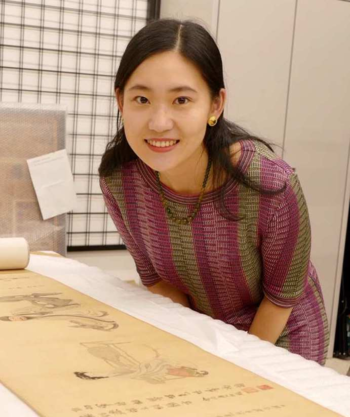Yizhou Wang

Fellow in the project "Epochal Lifeworlds: Narratives of Crisis and Change"
Short Biography
Yizhou Wang received her MLitt. in Arts of China from the University of Glasgow and in 2015 started her Ph.D. in Chinese Art History at the University of Heidelberg. Her dissertation focuses on the visual (self-)representations of courtesans (mingji名妓) in the Ming dynasty through the lens of gender. She worked at the Calligraphy and Painting Department of the Palace Museum Beijing in 2014. She also studied at SOAS University of London, Kyoto University, and Tokyo University. She developed an initial research interest in the artistic representations of plants since 2013 and published an article on the Chinese double lotus. In recent years, she has been working on human-nature interactions in arts and literature during the Ming-Qing transition. Her professional research interests include Chinese paintings (pre-modern), Ming-Qing visual and material culture, gender studies in art history, Sino-Japanese art interactions, (self-)portraiture, women artists, and early East Asian photography.
Project
Voices of Nature and Landscape in Artful Spaces of Transitions: From Ming-Qing to Contemporary ChinaWang Yizhou's research project focuses on the visual and literary representations of plants, e.g., willows, pine trees, and the natural landscape during the seventeenth-century Ming-Qing transition, an age when China experienced severe climate changes and deterioration in the “Little Ice Age” which led to the great famine, social unrest, and the governance vulnerability to the nomadic invasions. To survive in the severe natural and social disturbance, “moving” and “hiding” became two major interwoven themes in the Ming-Qing period. When the actual words or communications were difficult to come out for varied reasons during crises, creating imageries of nature, plants, and the landscape became a pathway for either personal or collective expressions as a means of relief and therapy. The human defense and confrontation in the Ming-Qing crises were transplanted to the pictorial and literary representations of plants and natural landscape. This project investigates the following questions: How might have the transitional epochs of constant changes, natural calamities, and social crises stimulated artistic innovations and creative cultural practices? How did artists or poets in China react to changes, represent human-nature relations in arts, and interact with nature in lived experiences and changing spaces? How could the representations of plants and natural landscape create “voices” for the human state of mind? How did the changing environment and landscape with its own agency alter our understanding and mind imagery of the world? Additionally, this research takes the artistic practices involving human-nature interactions in the 1950s-early 1960s and the post-1980s contemporary period (including the most recent pandemic era) into consideration. It attempts to discuss how the artistic and cultural practices of the past, particularly in the Ming-Qing transition, could have played a role in contemporary China and how the reflected ecological concepts of the past could dialogue with the present epoch experiencing transitions.
